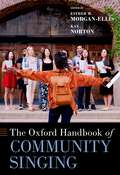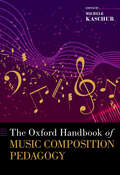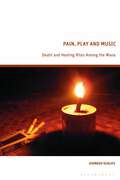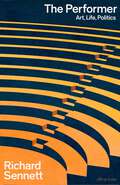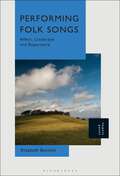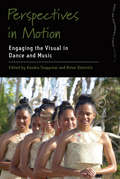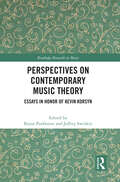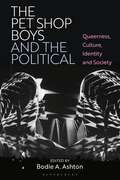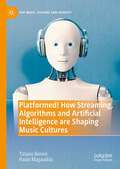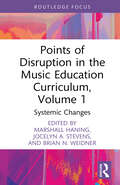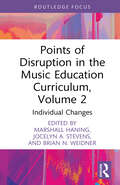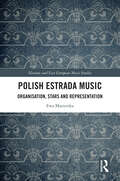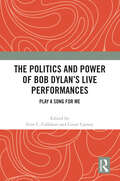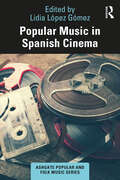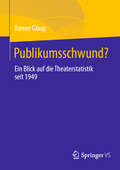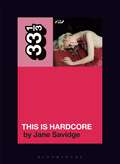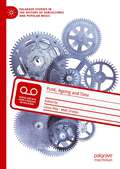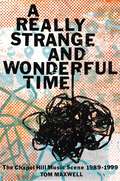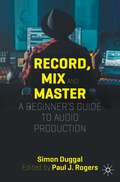- Table View
- List View
The Oxford Handbook of Community Singing (Oxford Handbooks)
by Esther M. Morgan-Ellis, Kay NortonThe Oxford Handbook of Community Singing embraces an open-ended interpretation of socio-musical practices that can be described with the term community singing. The volume exemplifies community singing as an interdisciplinary field of study that encompasses diverse methodologies and objects of inquiry, and in the process brings together recent research from the fields that have historically engaged with the practice of group singing, including group dynamics, ethnomusicology, music history, music education, music therapy, community music, church music, music performance, sociology, political science, Latin American and North American studies, media studies, embodied psychology, theology, and philosophy. Chapters are divided into eight interdisciplinary sections: "Media and the Imagination of Community", "Singing in Place-Based Communities", "The Practitioner's Perspective", "Identity: Values, Ethnicity, and Inherited Culture", "Identity: Politics, Patriotism, and Assimilation", "Transgressing Borders, Seeking Asylum", "Singing and Political Action", and "New Paradigms". Each is prefaced with an introduction that traces the common threads running through the methodologically and topically diverse chapters that examine culturally specific narrow instances of community singing, each confined to a given time and place, in significant detail. The chapters explore community singing as one of two phenomena: the practice of singing as community--the utilization of collective song by communities of place or preference, and the singing of community into existence--the creation or identification of a new community, through singing, that did not exist before. Both practices can profoundly affect participants. The Handbook considers why communities are motivated to sing, what their activities mean, and how practitioners can improve the experience of singing together.
The Oxford Handbook of Music Composition Pedagogy (OXFORD HANDBOOKS SERIES)
by Michele KaschubThe Oxford Handbook of Music Composition Pedagogy presents an illuminating collection of perspectives on teaching and learning in the field of music composition, supplying music educators with knowledge about young composers and their work. The Handbook's forward-looking practices offer teachers tools and strategies for every child to experience music composition as part of their music education. Editor Michele Kaschub, along with an outstanding team of contributing authors, offers a comprehensive handbook providing key scholarly, critical, and practical perspectives on teaching composers and learning to compose. Written by academic scholars, researchers, and music teachers, the 43 chapters of the volume addresses nine major themes: philosophical foundations; identity and inclusion; compositional processes; approaches to composition teaching and learning; nurturing young composers; composing in classroom and ensemble settings; international perspectives on composition in music education; and how the future of composition might be shaped. The Handbook provides strategies to readers in embracing diversity as it is found in the individual nature of each student-composer and in the broader community of composers. Kaschub proposes an understanding of the value of individual and collaborative work as a function of artistic action, including a wide-range range of experiential contexts so that students can embrace traditional and emerging music, and ways to help students sustain and extend their cultural heritage through composing. The Oxford Handbook of Music Composition Pedagogy underscores the potential that composition holds for advancing student artistry in music education while guiding educators working to achieve that goal.
Pain, Play and Music: Death and Healing Rites Among the Wana
by Giorgio ScaliciThe Wana people of Morowali accept the experiences of pain, illness and loss and transform them into something positive: rituals that celebrate life, friendship and the community. Through fieldwork with the Wana people of Morowali, Central Sulawesi, Giorgio Scalici shows how music serves as a connection between the human world and the hidden world of spirits and emotion.By examining rituals such as the momago, the main Wana healing ritual, and the kayori, the funeral, this book investigates how music is used by the Wana to heal people, control emotions, reinforce the sense of community and to mark the cultural death of the community member. In this study, music transforms the pain of loss into a playful event that heals the community and assures its future.This book will be of interest to the wider academic study of religion, anthropology and ethnomusicology as it looks as at funerals as healing rituals for the community which lead the living and the dead through critical times.
The Performer: Art, Life, Politics
by Richard SennettAn exploration of public performance in everyday life, by the leading cultural and social thinkerThe Performer explores the relations between performing in art (particularly music), politics and everyday experience. It focuses on the bodily and physical dimensions of performing, rather than on words. Richard Sennett is particularly attuned to the ways in which the rituals of ordinary life are performances.The book draws on history and sociology, and more personally on the author's early career as a professional cellist, as well as on his later work as a city planner and social thinker. It traces the evolution of performing spaces in the city; the emergence of actors, musicians, and dancers as independent artists; the inequality between performer and spectator; the uneasy relations between artistic creation and social and religious ritual; the uses and abuses of acting by politicians. The Janus-faced art of performing is both destructive and civilizing.This is the first in a trilogy of books on the fundamental DNA of human expression: performing, narrating, and imaging.
Performing Folk Songs: Affect, Landscape and Repertoire
by Dr. Elizabeth BennettPerforming Folk Songs is the first full-length volume to explore English folk singing from the perspective of performance studies. Using archival sources, family repertoire and recorded performances of interviewees, this book argues that archives and repertoires are produced in sensory environments and through embodied encounters. Autoethnography, sensory ethnography, life-writing and landscape writing are used to explore the affective and emotional aspects of learning songs 'by heart'. Drawing on her experience as a folk singer, Bennett contributes to discourse on English folk traditions in the 21st century and brings performance scholarship to the contemporary folk song resurgence. In analyzing the performance of English folk songs in the affective context of the archive and the landscape, the book engages with and contributes original insights to scholarship on folk music, performance studies, affect theory, cultural geography and intangible cultural heritage studies.
Perspectives in Motion: Engaging the Visual in Dance and Music (Dance and Performance Studies #15)
by Kendra Stepputat Brian DiettrichFocusing on visual approaches to performance in global cultural contexts, Perspectives in Motion explores the work of Adrienne L. Kaeppler, a pioneering researcher who has made a number of interdisciplinary contributions over five decades to dance and performance studies. Through a diverse range of case studies from Oceania, Asia, and Europe, and interdisciplinary approaches, this edited collection offers new critical and ethnographic frameworks for understanding and experiencing practices of music and dance across the globe.
Perspectives on Contemporary Music Theory: Essays in Honor of Kevin Korsyn (Routledge Research in Music)
Kevin Korsyn is a renowned music theorist, musicologist, and pedagogue who has taught at the University of Michigan since 1992. He has published widely and influentially in areas as diverse as Beethoven and Brahms studies, chromatic tonality, disciplinarity and metatheory, history of theory, musical meaning and hermeneutics, poststructuralism (deconstruction, intertextuality, etc.), and Schenkerian theory and analysis. Because of the scope and caliber of his published work, and also his legacy as a pedagogue, Korsyn has had a profound impact on the field of music theory, along with the related fields of historical musicology and aesthetics. This book, a festschrift for Korsyn, comprises essays that constellate around his numerous scholarly foci. Represented in the volume are not only familiar music-theoretical topics such as chromaticism, form, Schenker, and text-music relations, but also various interdisciplinary topics such as deconstruction, disability studies, German Idealism, posthumanism, and psychoanalysis. The book thus reflects the increasingly multifaceted intellectual landscape of contemporary music theory.
Perspectives on Contemporary Music Theory: Essays in Honor of Kevin Korsyn (Routledge Research in Music)
by Bryan Parkhurst Jeffrey SwinkinKevin Korsyn is a renowned music theorist, musicologist, and pedagogue who has taught at the University of Michigan since 1992. He has published widely and influentially in areas as diverse as Beethoven and Brahms studies, chromatic tonality, disciplinarity and metatheory, history of theory, musical meaning and hermeneutics, poststructuralism (deconstruction, intertextuality, etc.), and Schenkerian theory and analysis. Because of the scope and caliber of his published work, and also his legacy as a pedagogue, Korsyn has had a profound impact on the field of music theory, along with the related fields of historical musicology and aesthetics. This book, a festschrift for Korsyn, comprises essays that constellate around his numerous scholarly foci. Represented in the volume are not only familiar music-theoretical topics such as chromaticism, form, Schenker, and text-music relations, but also various interdisciplinary topics such as deconstruction, disability studies, German Idealism, posthumanism, and psychoanalysis. The book thus reflects the increasingly multifaceted intellectual landscape of contemporary music theory.
The Pet Shop Boys and the Political: Queerness, Culture, Identity and Society
by Bodie A. AshtonThe Pet Shop Boys came of age at a time of deep socio-political tension. From the rise of sexual politics and awareness to Thatcherite neoliberalism and the Cold War, this book explores the cultural and political impact of the band and offers a fascinating window into the late 20th and early 21st centuries. An archetypal 'gay band', it shows how their overt queerness influenced generations of LGBTQIA+ music lovers and artists alike. Covering the full oeuvre of The Pet Shop boys; their albums, films, stage productions and collaborations, chapters in this collection show how their work is suffused with political commentary on the past and present covering themes as broad as queer identity, the HIV/AIDs epidemic, globalization and Brexit. It also places them within the context of their times and considers them as activists, authors, social commentators, political actors and personalities to better understand what influenced them. Bringing together a range of perspectives and disciplines, The Pet Shop Boys and the Political provides a unique and untapped insight into a formative pop band of the modern era that has mirrored and shaped society over the past forty years.
Platformed! How Streaming, Algorithms and Artificial Intelligence are Shaping Music Cultures (Pop Music, Culture and Identity)
by Tiziano Bonini Paolo MagauddaGrounded in more than a decade of field research, this book uses empirical examples, quantitative data, and qualitative interviews with young music consumers as well as music industry professionals to understand how the platforms behind music production, distribution and listening work in our digital society. Bringing together the perspectives from science and technology studies, media studies, and the political economy of digital platforms, the book outlines the process of mutual construction between music digital platforms and the cultural value of music in today’s society, and also reflects on the complicated relationship between the power of platforms and the agency of listeners.
Points of Disruption in the Music Education Curriculum, Volume 1: Systemic Changes (CMS Pedagogies and Innovations)
by Marshall Haning Jocelyn A. Stevens Brian N. WeidnerFor decades, scholars in the field of music education have recognized the need for growth and change in our approach to teaching music, yet despite these calls for change, the music education curriculum today remains remarkably similar to that of a century ago. Points of Disruption in the Music Education Curriculum, Volume 1: Systemic Changes is one of two volumes that bring together applied suggestions, analyses, and best practices for disrupting cycles of replication in the curriculum of K-12 and collegiate music education programs in the United States and beyond, considering disruption as a force for positive change. Identifying specific strategies for interrupting or reimagining traditional practices, the contributors provide music teachers and music educators with a variety of potential practical approaches to creating changes that foster a better musical education at all levels of the curriculum.This first volume focuses on systemic changes, including topics like professional development, hiring practices, ableism and universal design, rhizomatic learning, and how to implement disruption across the music education profession. Each chapter contains specific action steps and suggestions for implementation. Bringing together five thought-provoking chapters, this concise volume offers a diverse set of concrete strategies that will be useful to a wide range of music education stakeholders, including teachers, administrators, and curriculum designers.
Points of Disruption in the Music Education Curriculum, Volume 1: Systemic Changes (CMS Pedagogies and Innovations)
by Marshall Haning Jocelyn A. Stevens Brian N. WeidnerFor decades, scholars in the field of music education have recognized the need for growth and change in our approach to teaching music, yet despite these calls for change, the music education curriculum today remains remarkably similar to that of a century ago. Points of Disruption in the Music Education Curriculum, Volume 1: Systemic Changes is one of two volumes that bring together applied suggestions, analyses, and best practices for disrupting cycles of replication in the curriculum of K-12 and collegiate music education programs in the United States and beyond, considering disruption as a force for positive change. Identifying specific strategies for interrupting or reimagining traditional practices, the contributors provide music teachers and music educators with a variety of potential practical approaches to creating changes that foster a better musical education at all levels of the curriculum.This first volume focuses on systemic changes, including topics like professional development, hiring practices, ableism and universal design, rhizomatic learning, and how to implement disruption across the music education profession. Each chapter contains specific action steps and suggestions for implementation. Bringing together five thought-provoking chapters, this concise volume offers a diverse set of concrete strategies that will be useful to a wide range of music education stakeholders, including teachers, administrators, and curriculum designers.
Points of Disruption in the Music Education Curriculum, Volume 2: Individual Changes (CMS Pedagogies and Innovations)
by Marshall Haning Jocelyn A. Stevens Brian N. WeidnerFor decades, scholars in the field of music education have recognized the need for growth and change in our approach to teaching music, yet despite these calls for change, the music education curriculum today remains remarkably similar to that of a century ago. Points of Disruption in the Music Education Curriculum, Volume 2: Individual Changes is one of two volumes that bring together applied suggestions, analyses, and best practices for disrupting cycles of replication in the curriculum of K-12 and collegiate music education programs in the United States and beyond, considering disruption as a force for positive change. Identifying specific strategies for interrupting or reimagining traditional practices, the contributors provide music teachers and music educators with a variety of potential practical approaches to creating changes that foster a better musical education at all levels of the curriculum.This second volume focuses on changes that can be implemented by individual educators, covering topics including transcultural approaches, student-teacher power relations, methods courses, integrated music education, and administrator support of teacher agency, student–teacher power relations, and reimagining music education. Bringing together 6 thought-provoking chapters, this book offers a diverse set of concrete strategies that will be useful to a wide range of music education stakeholders, including teachers, administrators, and curriculum designers.
Points of Disruption in the Music Education Curriculum, Volume 2: Individual Changes (CMS Pedagogies and Innovations)
by Marshall Haning Jocelyn A. Stevens Brian N. WeidnerFor decades, scholars in the field of music education have recognized the need for growth and change in our approach to teaching music, yet despite these calls for change, the music education curriculum today remains remarkably similar to that of a century ago. Points of Disruption in the Music Education Curriculum, Volume 2: Individual Changes is one of two volumes that bring together applied suggestions, analyses, and best practices for disrupting cycles of replication in the curriculum of K-12 and collegiate music education programs in the United States and beyond, considering disruption as a force for positive change. Identifying specific strategies for interrupting or reimagining traditional practices, the contributors provide music teachers and music educators with a variety of potential practical approaches to creating changes that foster a better musical education at all levels of the curriculum.This second volume focuses on changes that can be implemented by individual educators, covering topics including transcultural approaches, student-teacher power relations, methods courses, integrated music education, and administrator support of teacher agency, student–teacher power relations, and reimagining music education. Bringing together 6 thought-provoking chapters, this book offers a diverse set of concrete strategies that will be useful to a wide range of music education stakeholders, including teachers, administrators, and curriculum designers.
Polish Estrada Music: Organisation, Stars and Representation (Slavonic and East European Music Studies)
by Ewa MazierskaPolish estrada music dominated Polish popular music throughout the state socialist period but gained little attention from popular music scholars because it was regarded as being of low quality and politically conformist. Ewa Mazierska carefully examines these assumptions, considering those institutions which catered for the needs of estrada artists and their fans, the presence of estrada in different media and the careers and styles of the leading stars, such as Mieczysław Fogg, Irena Santor, Violetta Villas, Anna German, Jerzy Połomski, Maryla Rodowicz, Zdzisława Sośnicka, Zbigniew Wodecki and Krzysztof Krawczyk. Mazierska also discusses the memory and legacy of estrada music in the post-communist period. The book draws on Poland’s cultural and political history and the history of Polish popular music and media, including television and radio. Mazierska engages with concepts such as genre, stardom and authenticity in order to capture the essence of Polish estrada music and to provide a comparison with popular music produced in other countries.
Polish Estrada Music: Organisation, Stars and Representation (Slavonic and East European Music Studies)
by Ewa MazierskaPolish estrada music dominated Polish popular music throughout the state socialist period but gained little attention from popular music scholars because it was regarded as being of low quality and politically conformist. Ewa Mazierska carefully examines these assumptions, considering those institutions which catered for the needs of estrada artists and their fans, the presence of estrada in different media and the careers and styles of the leading stars, such as Mieczysław Fogg, Irena Santor, Violetta Villas, Anna German, Jerzy Połomski, Maryla Rodowicz, Zdzisława Sośnicka, Zbigniew Wodecki and Krzysztof Krawczyk. Mazierska also discusses the memory and legacy of estrada music in the post-communist period. The book draws on Poland’s cultural and political history and the history of Polish popular music and media, including television and radio. Mazierska engages with concepts such as genre, stardom and authenticity in order to capture the essence of Polish estrada music and to provide a comparison with popular music produced in other countries.
The Politics and Power of Bob Dylan’s Live Performances: Play a Song for Me
by Erin C Callahan Court CarneyEphemeral by nature, the concert setlist is a rich, if underexplored, text for scholarly research. How an artist curates a show is a significant aspect of any concert’s appeal. Through the placement of songs, variations in order, or the omission of material, Bob Dylan’s setlists form a meta-narrative speaking to the power and significance of his music. These essays use the setlists from concerts throughout Dylan’s career to study his approach to his material from the 1960s to the 2020s. These chapters, from various disciplinary perspectives, illustrate how the concert setlist can be used as a source to explore many aspects of Dylan’s public life. Finally, this collection provides a new method to examine other musicians across genres with an interdisciplinary approach to setlists and the selectivity of performance. Unique in its approach and wide-ranging scholarly methodology, this book deepens our understanding of Bob Dylan, the performer.
The Politics and Power of Bob Dylan’s Live Performances: Play a Song for Me
Ephemeral by nature, the concert setlist is a rich, if underexplored, text for scholarly research. How an artist curates a show is a significant aspect of any concert’s appeal. Through the placement of songs, variations in order, or the omission of material, Bob Dylan’s setlists form a meta-narrative speaking to the power and significance of his music. These essays use the setlists from concerts throughout Dylan’s career to study his approach to his material from the 1960s to the 2020s. These chapters, from various disciplinary perspectives, illustrate how the concert setlist can be used as a source to explore many aspects of Dylan’s public life. Finally, this collection provides a new method to examine other musicians across genres with an interdisciplinary approach to setlists and the selectivity of performance. Unique in its approach and wide-ranging scholarly methodology, this book deepens our understanding of Bob Dylan, the performer.
Popular Music in Spanish Cinema (Ashgate Popular and Folk Music Series)
by Lidia López GómezPopular Music in Spanish Cinema analyses the aesthetics and stylistic development of soundtracks from national productions, considering how political instability and cultural diversity in Spain determined the ways of making art and managing culture. As a pioneering study in this field, the chronologically structured approach of this book provides readers with a complete overview of Spanish music and connects it to the complex historical events that conditioned Spanish culture throughout the 20th century to the present day, from the Second Republic, the Spanish Civil war, and the dictatorship through to democracy. The book enables an understanding of the relationships between the recording and film production industries, the construction of collective imagination, the formulation of new stereotypes, semiotic meanings within film music and the musical exchanges between national and international cinema. This volume is an essential read for students and academics in the field of musicology, ethnomusicology and history as well as those interested in the study of diverse musical styles such as copla, zarzuela, flamenco, jazz, foxtrot, pop and rock and how they have been used in Spanish films throughout history.
Popular Music in Spanish Cinema (Ashgate Popular and Folk Music Series)
Popular Music in Spanish Cinema analyses the aesthetics and stylistic development of soundtracks from national productions, considering how political instability and cultural diversity in Spain determined the ways of making art and managing culture. As a pioneering study in this field, the chronologically structured approach of this book provides readers with a complete overview of Spanish music and connects it to the complex historical events that conditioned Spanish culture throughout the 20th century to the present day, from the Second Republic, the Spanish Civil war, and the dictatorship through to democracy. The book enables an understanding of the relationships between the recording and film production industries, the construction of collective imagination, the formulation of new stereotypes, semiotic meanings within film music and the musical exchanges between national and international cinema. This volume is an essential read for students and academics in the field of musicology, ethnomusicology and history as well as those interested in the study of diverse musical styles such as copla, zarzuela, flamenco, jazz, foxtrot, pop and rock and how they have been used in Spanish films throughout history.
Publikumsschwund?: Ein Blick auf die Theaterstatistik seit 1949
by Rainer GlaapDurch den teils massiven Publikumsschwund nach der Pandemie stellt sich die Frage, ob diese als Brandbeschleuniger gewirkt hat für bereits vorhandene Trends. Der Autor geht dem nach anhand der Besuchszahlen bis zur letzten vollständigen vorpandemischen Spielzeit 2018/19. Er zeigt historische Zeitreihen zu Sparten- und Personalentwicklung, Vertriebskanälen und den Einnahmen. Die Theaterstatistik des Bühnenvereins dient vielen Entscheidungsträgern als Grundlage für z.B. kulturpolitische Steuerungen, obwohl sie nicht die komplette deutsche Theaterlandschaft abbildet. Deshalb beleuchtet der Autor weitere Anbieter. Da die Theaterstatistik große kulturpolitische Bedeutung hat, gibt es zum Schluss einige Vorschläge für die Zukunft.
Pulp's This Is Hardcore (33 1/3)
by Jane SavidgeThis Is Hardcore is Pulp's cry for help. A giant, sprawling, flawed masterpiece of a record, the 1998 album manages to tackle some of the most inappropriate grown-up issues of the day – fame, ageing, mortality, drugs, and pornography – and still come out crying and laughing on the other side. The subject of pornography dominates the record – from its controversial artwork to the images conjured up by songs like "Seductive Barry" and the title track – after Pulp's main man, Jarvis Cocker – who'd spent most of his teenage and adult life chasing celebrity, only to be cruelly disappointed when it finally arrived in spades – hit upon the grand notion of using pornography as a metaphor for fame. The album's commercial failure as a follow-up to the band's Britpop-defining, Different Class, also symbolizes a death knell for Britpop itself. Dark, right? Except just like Pulp themselves, Jane Savidge's book is playful and sometimes very funny indeed. Kicking off with an imaginary conversation between Jarvis Cocker and the people who run the Total Fame Solutions helpline, Savidge expertly guides us through the trials and tribulations of an album that begins with the so-called Michael Jackson Incident, when Cocker got up on stage at the 1996 Brit Awards and waggled his fully-clothed bum at the King of Pop. Pulp's This Is Hardcore may be a sleazy run through porn and mental demise, and an album that chronicles Cocker's continuing disillusionment with his newfound lot in life, but Savidge's book assesses the cultural and historical context of the album with insider knowledge and a sharp modern lens, ultimately making a case for it as one of the most important albums of the 1990s.
Punk, Ageing and Time (Palgrave Studies in the History of Subcultures and Popular Music)
by Laura Way Matt GrimesTo date there has been no plotting of punk scholarship which speaks to ‘time’, yet there are some clear bodies of work pertaining to particular issues relevant to it, including ageing and/or the life course and punk, memory and/or nostalgia and punk, ‘punk history’, and archiving and punk. Punk, Ageing and Time is therefore a timely (pun intended) book. What this edited collection does for the first time is bring together contemporary investigations and discussions specifically around punk and ageing and/or time, covering areas such as: punk and ageing; the relationship between temporality and particular concepts relevant to punk (such as authenticity, DIY, identity, resistance, spatiality, style); and punk memory, remembering and/or forgetting. Multidisciplinary in nature, this book considers areas which have received very little to no academic attention previously.
A Really Strange and Wonderful Time: The Chapel Hill Music Scene: 1989-1999
by Tom MaxwellTHE FIRST BIOGRAPHY OF THE THRIVING AND INFLUENTIAL ROCK SCENE IN CHAPEL HILL, WHICH GAVE THE WORLD ARTISTS LIKE BEN FOLDS FIVE, SUPERCHUNK, AND SQUIRREL NUT ZIPPERS North Carolina has always produced extraordinary music of every description. But the indie rock boom of the late 1980s and early &’90s brought the state most fully into the public consciousness, while the subsequent post-grunge free-for-all bestowed its greatest commercial successes. In addition to the creation of legacy label Merge Records and a slate of excellent indie bands like Superchunk, Archers of Loaf, and Polvo, this was the decade when other North Carolina artists broke Billboard &’s Top 200 and sold millions of records—several million of which were issued by another indie label based in Carrboro, Chapel Hill&’s smaller next-door neighbor. It&’s time to take a closer look at exactly what happened.A Really Strange and Wonderful Time features a representative cross section of what was being created in and around Chapel Hill between 1989 and 1999. In addition to the aforementioned indie bands, it documents—through firsthand accounts—other local notables like Ben Folds Five, Dillon Fence, Flat Duo Jets, Small, Southern Culture on the Skids, The Veldt, and Whiskeytown. At the same time, it describes the nurturing infrastructure which engendered and encouraged this marvelous diversity. In essence, A Really Strange and Wonderful Time is proof of the genius of community.
Record, Mix and Master: A Beginner’s Guide to Audio Production
by Simon DuggalThis textbook is a practical guide to achieving professional-level audio productions using digital audio workstations. It contains 27 chapters divided into three sections, with specially devised diagrams and audio examples throughout. Aimed at students of all levels of experience and written in an easy-to-understand way, this book simplifies complex jargon, widening its appeal to non-academic creatives and is designed to accelerate the learning of professional audio processes and tools (software and hardware).The reader can work through the book from beginning to end or dip into a relevant section whenever required, enabling it to serve as both a step by step guide and an ongoing reference manual. The book is also a useful aid for lecturers and teachers of audio production, recording, mixing and mastering engineering.
